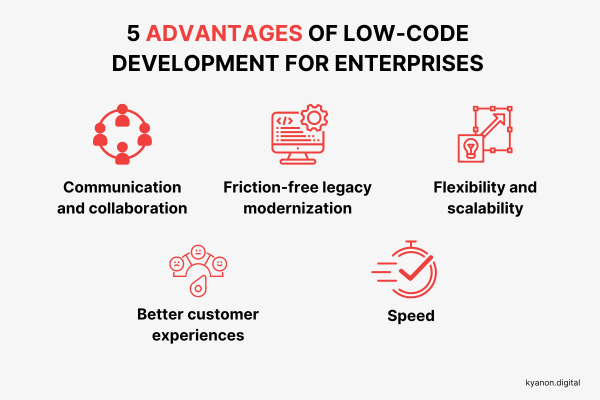Recommended Info For Picking Low-Code Platform Recommendations
Recommended Info For Picking Low-Code Platform Recommendations
Blog Article
Benefits Of Low-Code Development In The Area Of Speed
Visual Development Environment (VDE):
Drag-and-Drop Interfaces: Low-code platforms provide visual tools for designing applications. Drag-and-drop elements let developers quickly create applications without the need to write lengthy code.
Many low-code platforms include pre-built templates and components that permit developers to quickly test their apps and then build them without needing to start from scratch.
Reduced Coding Requirements:
Automated code generation: Low-code platforms generate the codes that are used to build them based on models that are visual and maintained by the developers. This removes the need to write the code manually and accelerates the development process.
Reusable Components: Developers may use reusable components across different projects, minimizing the time spent on creating and testing code.
Collaboration streamlined:
Low-code platform tools often contain versions control, testing, or deployment. This allows for the seamless communication between teams.
Citizen Development (Citizen Development) User and non-developers of business applications can participate in application development using intuitive interfaces. This helps to reduce the bottleneck caused by the limited professional developer availability.
Rapid Iteration and Prototyping
Rapid prototyping: Designers are able to quickly create prototypes to collect feedback and validate concepts, which leads to faster iteration cycles.
Simple modifications. The visual interface low-code development provides makes it simple to update and change applications. This speed up the process of enhancing and improving applications in response to the feedback of users.
Pre-built Integrations:
API Integrations: Platforms that are low-code usually have pre-built connectors for popular services and APIs, reducing the time required to connect external systems.
Data Integration: Built-in tools for data integration make it easier to process of connecting databases and other sources of information and speeding development.
Scaling deployment:
A lot of low-code platforms offer the option of deploying applications with one click which can reduce the amount of time and effort needed to deploy applications.
Cloud-based solutions: Cloud platforms with low-code let developers focus on the design and function of their applications, rather than worrying about the logistics of deployment.
Overall, the advantage of low-code application development in terms of speed lies in the ability of it to streamline and automate various aspects of the development process, enabling quicker delivery of applications as well as more rapid adaptation to evolving requirements. See the most popular for beginners on Low-code Platform for application development for more info including app development platform, application modernization, cross platform mobile app development, develop mobile application, application modernization software, application modernization, microsoft azure sql, app modernisation, low code development platforms, push alerts and more.
The Benefits Of Low-Code Development In Terms Of Flexibility, Scalability And Scalability
Low-code development of apps offers many advantages, including scalability and a flexible design for the application. These are important in creating apps that adapt to changing needs and grow with the business. Here are a few major advantages Rapid scaling:
Cloud-Based Platforms: A large number of platforms that are low-code-friendly use cloud computing. They permit applications to easily scale up and down with the cloud infrastructure. Businesses can manage increased workloads without having to worry about managing servers.
Auto-Scaling Functions: Auto-scaling features can be utilized to adjust resources automatically in response to the demand. They make sure that performance is consistent in peak hours.
Flexible Architecture:
Modular Design: Low-code systems promote modular design of applications, in which components can be independently developed test, scaled, and then redesigned. Modularity allows for greater flexibility, and makes it easier to modify specific elements of an app without having to change the entire system.
Integration of microservices: The support offered by the microservices architecture enables applications to be built as a collection of loosely connected services. This enhances both scalability, and flexibility.
Customizable Solutions:
Extensibility: Low code platforms generally allow for customized scripting and programming that lets developers expand the capabilities of their applications beyond that available out-of the-box. This allows companies to meet their specific requirements.
Third-Party Integrations: The capability to connect with third-party services and APIs permits businesses to incorporate additional functionalities and services when needed to enhance the functionality of the application.
Agile Development and Deployment
Continuous Delivery & Deployment Low-code Platforms can support agile methods through enabling continuous integration and Continuous Delivery (CI/CD). This allows rapid release of updates and features. Applications are then able to change quickly in response to market changes and user feedback.
Iterative Devlopment: Due to the nature of iterative development low-code software can grow and improve slowly. This helps reduce the risks associated with significant changes and allows for greater control over expansion.
Resource Optimization
Effective Resource Management Low Code platforms optimize the use of resources through tools that monitor and manage the performance of a program. This makes sure that resources are used effectively and can be scaled to meet actual needs.
Load Balancing: The integrated load balancing capabilities distribute the burden equally across servers, increasing the capacity of applications to handle high traffic and ensure consistent performance.
Global Reach
Multi-Region: Low-code platform deployments are frequently accessible across multiple countries and allow businesses to provide users with low latency access to all users. This is especially important for apps that have a large global user base.
Localization Support The built-in support for language localization enables applications to easily be adapted to different local languages and requirements which allows them to adapt to different markets.
Maintenance and updates
Simplified maintenance: The graphic and module design of low code applications simplifies maintenance tasks. They allow upgrades and bug fixes to be made quickly without extensive downtime.
Version Control: A fully integrated version control software helps manage changes and rolls backs. This makes sure that updates can be easily installed and older versions restored if required.
Cost Efficiency:
Low-code platforms can cut development costs by reducing the requirement for extensive code. They also make it possible to scale applications with no need for a significant expenditure or effort.
Pay-As-You Go Models - Many low-code platforms offer flexible pricing models such as pay-as you-go that adjusts prices to the actual usage, growth, as well as financial flexibility.
In general, low-code development provides businesses with the flexibility and capacity they require to develop robust and adaptable applications. These platforms can quickly adjust to changing demands and make the most efficient use of resources, and continually improve, allowing apps and companies alike to grow and expand. Have a look at the best from this source about Enterprise application development with Low-code Platform for website examples including develop web app, build with docker, cross platform app development, paas service, push alerts, lowcode no code, azure sql server, jdbc server, azure sql server, cloud software applications and more.
The Benefits Of Developing Applications Using Low-Code In Collaboration And Workflow
Low-code applications offer a number of advantages when it comes to collaboration and workflow, which makes it an the perfect choice for businesses seeking to improve team efficiency and streamlining development processes. Here are some key advantages.
Unified Development Environment : Low-code platforms offer a unified, single environment where all team members are able to work effectively including designers, business analysts and stakeholders. This eliminates the silos that exist and encourages better communication.
Visual Development Tools: The visual drag-and-drop feature of low-code platforms makes it easy for non-technical team members to participate in the process of development, ensuring that the requirements of the business are correctly recorded and implemented.
Communication Improved:
Real-Time Collaboration: A lot of low-code platforms have real-time collaboration options, such as simultaneous editing, commenting and instant feedback, which allow for continuous communication and decrease the time spent on back-and-forth discussions.
Shared Workspaces: Teams are able to collaborate in shared workspaces, in which they can review, edit, and discuss aspects of projects, ensuring that everyone's on the same page, and working towards the same goals.
Streamlined Workflow
Built-in Tools for Project Management: Platforms that are low-code usually include integrated tools for managing projects that help teams plan, track, and manage their development initiatives. This includes task assignment along with progress tracking and deadline management.
Automating repetitive workflows and tasks reduces the chance of errors and manual work, allowing teams and individuals to focus more on strategic initiatives and improve efficiency.
Speedier Iteration Cycles:
Rapid Prototyping : Low-code systems enable rapid prototyping. They also allow rapid and iterative development. This allows teams to develop applications, test and refine them within shorter time frames. This allows for feedback to be incorporated quickly into the application and rapid enhancements.
Agile Development Support Facilitating agile methodologies allows individuals and teams to work in smaller increments. This allows them to quickly adapt to changes.
Accessibility for non-developers
Citizen development: Low-code platforms permit business users to modify and develop applications with no programming expertise. This frees IT and Development teams of the burden and allows faster responses to business requirements.
Training and Onboarding: Easy interfaces and a wealth of training materials make it easy for new members of the team to become familiar with the team and improve the overall cohesion within the team.
Centralized Knowledge Sharing and Documentation:
Integrated documentation Low-code features typically permit you to make and manage documents inside the platform. All information about your project is centrally accessible and easy to access.
Knowledge Repositories Teams are able to create and maintain repositories of information which include best practices, templates, and reuseable elements, which facilitate the sharing of information and reducing the amount of duplicate information.
Consistency and Standardization
Standardized Components: The use of pre-built, standardized components provides the sameness between the different applications. This makes it easier for members of the team to understand different parts of a specific project and then work on these components.
Compliance and governance Frameworks built-in for governance assure that all applications are created in line to organizational standards, regulatory requirements and standards for quality. They reduce the risk of not adhering to regulations and assure that the application meets specifications.
Feedback and Improvement Loops
Integrated Feedback Mechanisms Low-code platforms typically have integrated feedback mechanisms, allowing users to easily give feedback on applications, which can then be incorporated into the process of development.
Continuous Improvement - The ability to rapidly iterate, deploy and change applications in response to user feedback allows them to be aligned to the company's goals and users' requirements.
Visualization and reporting:
Real-time Analytics: Built-in analysis and reporting provides real-time insights into project performance, user interactions and the progress. Data-driven decision-making is possible.
Visual Workflow Maps: Tools to map workflows or processes can be useful for teams to comprehend their processes. They also help to identify bottlenecks and areas that need improvement.
When it comes to collaboration, low-code applications are ideal for reducing workflows, bring teams from different backgrounds together and streamline tasks. This creates a collaborative, agile, and efficient development environment that leads to higher-quality apps.